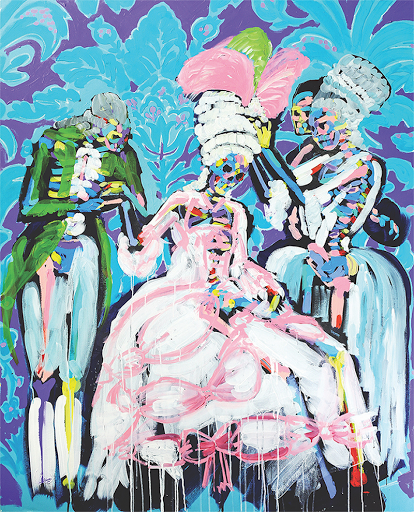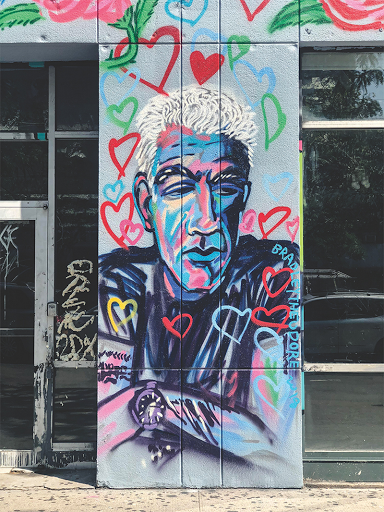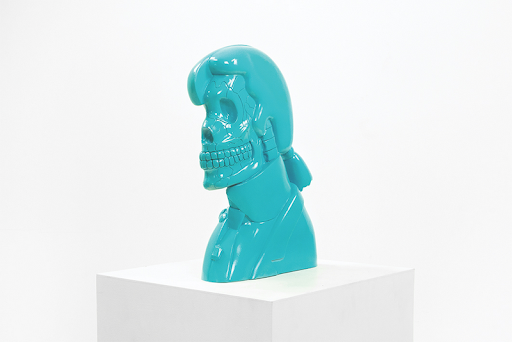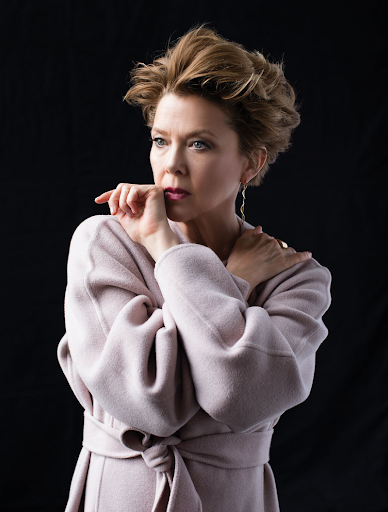ART
PAINT THE TOWN: BRADLEY THEODORE TALKS STREET ART, FAMOUS FIGURES IN FASHION, AND HIS LATEST PROJECTS
ART
by BRADLEY THEODORE
INTERVIEW
by MILENA DEDOVICH
WEB EDIT
by GRACE GARRAHAN
New York City-based visual artist Bradley Theodore is a reputable name in the world of street art, known for his signature skull motifs and skeletal interpretations of pop-culture icons marked with vivid brush strokes and saturated colors. His most notorious image, which can be seen on the walls of buildings in New York City, is of Vogue editor-in-chief, Anna Wintour, and fashion designer, Karl Lagerfeld, in a face-off. Their chic, skeletal likenesses are adorned in their familiar dress: Wintour, with her signature bob and sunglasses, and Lagerfeld in his classic ponytail and white collared shirt.
Street artists, originally demeaned as graffiti artists, first made their mark in the art world by creating viable and collectible art in the 80s. The movement has most definitely revived in the last 10 years with artists such as JR and Banksy whose work addresses political and social themes. Theodore frequently uses figures in fashion as his subjects, which was once consider taboo in the art world. Through this, he makes a bold statement on his view of the future of fashion and art. Theodore reveals to AS IF what drives his creative power, his thoughts on the relationship between fashion and art, and what the biggest obstacles are when the street becomes his canvas.
AS IF: You became famous by portraying fashion icons mostly, such as Kate Moss, Karl Lagerfeld, Coco Chanel, and Anna Wintour. What do you find fascinating about these fashion icons?
Bradley Theodore: The time I first started hanging out in downtown New York the presence of fashion figures was just a part of the lifestyle. But, New York has changed in the last few years and you don’t see these people as much as you used to. You used to go to parties downtown, and all of a sudden you’d see Kate Moss, or Karl Lagerfeld, and that was a part of my lifestyle. When I started to paint, I wanted to paint what I enjoyed, and I enjoyed fashion; I like fashion, and I always collected fashion magazines. I’m friends with fashion designers and used to hang out with Donna Karan at her home. It was always part of my lifestyle, so I decided if I was going to paint a subject it was going to be whatever I enjoyed. It’s always been hard to merge art and fashion, and it’s still the Holy Grail for a lot of artists to do that.
Your artworks are often inspired by contemporary fashion. Which aspects of contemporary fashion do you find intriguing?
Some pieces of my work talk about the history of fashion, and you can see this in my work such as my pieces on Queen Elizabeth. Monarchs were the first to have commissioned wardrobes. My renaissance pieces are all about renaissance fashion and the lifestyle. Fashion was important during this time period, and art patrons were some of the first sponsors of fashion designers. Fast forward to today where we live are in an era where major corporations dictate where fashion is heading. My first street piece was of Karl and Anna, and my second piece was of Diana Vreeland. I wasn’t creating these works to just depict fashion icons, but as an homage to the rich history of fashion. I chose to paint Diana Vreeland because of the important things she brought to fashion. She was the editor-in-chief of Harper’s Bazaar before going to Vogue where she brought in Andy Warhol and Dennis Hopper as contributors, started the Fashion Institute at The Metropolitan Museum of Art, and that set the tone for what we have today.
Your art is recognized by skull motifs and vivid skeletal interpretations. Tell me where this idea behind portraying people as skeletons comes from?
I wanted to portray the energy, individuality, and soul of the person. I didn’t want to get caught up on race, sex, or skin tone. So, the skeleton represents the life force of the individual I paint. For example, with Anna and Karl it was all about the relationship between them and how they are connected, whether you could see it or not. One affects the other and vice versa. I’m not painting a skeleton, I’m painting people as we should see them, as equals.

Portrait of Bradley Theodore by Tatijana Shoan
Who has been your most inspiring subject?
My most inspiring subject to paint is Marie Antoinette, due in large part to the opulence, luxury, and vulnerability she represents. I lived across the road from the Louvre in Paris for four years during my early painting career and spent a lot of time walking through it and its surrounding areas contemplating her era.
I read that Frida Kahlo is a big inspiration for you. What is it about her and her work that you draw inspiration from?
One of my ex-girlfriends was obsessed with her, used to dress like her and do her eyebrows the same. Basically, I felt like I lived with Frida Kahlo, so she became dear in my heart and part of my life.

Marie Antoinette, 2017, oil on canvas. Bradley Theodore
Tell me about your Puma collaboration, and your thoughts on artists collaborating with brands.
Most people who work with their hands call themselves artisans, and mural painters are artisans and we’re always working for somebody who helps us finance and create our concepts. Today’s brands are like yesteryears dukes, kings, or wealthy businessmen who commissioned artists. Working for brands allows an artist to expand their viewership. Warhol did a limited edition T-shirt collection, and Keith Haring did a swatch collaboration, so this idea has been part of the art world for a while now. I have a two-part collaboration with Puma. The first phase is for their 50th anniversary where they chose a capsule pack that consists of a suede shoe, track jacket, track pants, and a matching tee. The second part is a full capsule collection launching in January. A lot of people can’t afford one of my paintings, and this allows them to own something that I have created. A kid could wear one of my Puma shoes and 20 years later he’ll say I want that guy’s work because that reminds me of the time when I was a kid!
Do you have a favorite fashion designer you would like to collaborate with?
I’m more attracted to fashion houses that are bold enough to say, we see your talent, we see how you’ve changed the landscape of street art, we’d like to invite you to create something that would be kind of mind blowing. I just did collaboration with the Regent Hotel Montenegro. The Port of Montenegro invited me as their guest to create works that would connect with the people of Montenegro, embracing the themes fashion, music, and sports. My Anna and Karl piece was mounted onto an ex Cold War submarine. Look, if you open the door and let me in, I’ll help you create a party!

Anna & Karl diptych, 2017, acrylic on canvas. Bradley Theodore
“I wanted to portray the energy, individuality, and soul of the person. I didn’t want to get caught up on race, sex, or skin tone. So, the skeleton represents the life force of the individual I paint.”
Who are your biggest influences?
Artistically, I like Picasso’s work ethics, I love Kehinde Wiley, especially in terms of him representing the new generation of black artists. My good friend, artist Ray Smith, has always been consulting me. He was introduced to the art world through Andy Warhol and Jean-Michel Basquiat. Truly, I take inspiration from all artists.
What is the experience for you as an artist when you paint in a studio as opposed to the street?
On the street you get direct reactions from people, they’ll look at the work and tell you whether they like it or not. That’s what I was dealing with when I decided to paint Anthony Bourdain, which was a hard choice. I’m looking at this wall, and I see what piece should go on the wall and I knew I gotta paint Anthony Bourdain, and it was a complex decision on how to do it. It was a very hard painting to paint, but the responses have been just amazing, people have been thanking me, it’s good energy.

Anthony Bourdain Memorial Wall, NYC, 2018. Bradley Theodore

Kate, 2016, acrylic on canvas. Bradley Theodore

Karl In Paris, 2016, acrylic on cold press paper.
Bradley Theodore
What would you do if you weren’t an artist?
I pretty much tried everything, and I’m not very good at anything else. I think everything that I failed at brought me to this place because I acquired valuable skills along the way. I didn’t want to be an artist, I wasn’t really a big fan of the art world and the politics of it, which is why I like street art.
What’s next?
My team and I are looking to build a studio in Turks and Caicos. I have family roots there so I go there frequently to unwind, find inspiration, escape the New York mayhem, and re-energize between projects. I hope that I will be able to give back to this special place by building a studio there, hopefully re-energizing the art scene of the islands. I’m in a show in Beijing, I’m also doing a show in Shanghai. I am doing a lot of charity work with my team around the globe. We helped raise almost half a million dollars for a charity. We were doing charity work across London, China, and the US including Caudwell Foundation, Joe Namath Foundation, Buzz Art, the Tianchen Times, and a few more. We’re also doing charity work in Vietnam to help develop a school for kids. We helped build a special medical facility in the UK for the Karloff Foundation. There’s a lot of stuff in the works, but the biggest push now is a collaboration we’re doing in China, which will be really great. Life is good, there are great activations coming-up, people want to see my work.

Emperor, 2016, acrylic on canvas. Bradley Theodore
“Today’s brands are like yesteryears dukes, kings, or wealthy businessmen who commissioned artists. Working for brands allows an artist to expand their viewership.”

The Second Coming – Paint the Wraith, Maddox Gallery, 2017. Bradley Theodore










MORE FROM AS IF

© 2018, AS IF MEDIA GROUP
ALL RIGHTS RESERVED
AS IF MAGAZINE
ABOUT
CONTACT
NEWSLETTER
PRIVACY POLICY
TERMS OF USE
SITE MAP
SUBSCRIPTION
SUBSCRIBE
CUSTOMER SERVICE
SEND A GIFT
SHOP
PRESS CENTER
ADVERTISING
IN THE PRESS
GET IN TOUCH
FOLLOW US
YOUTUBE




